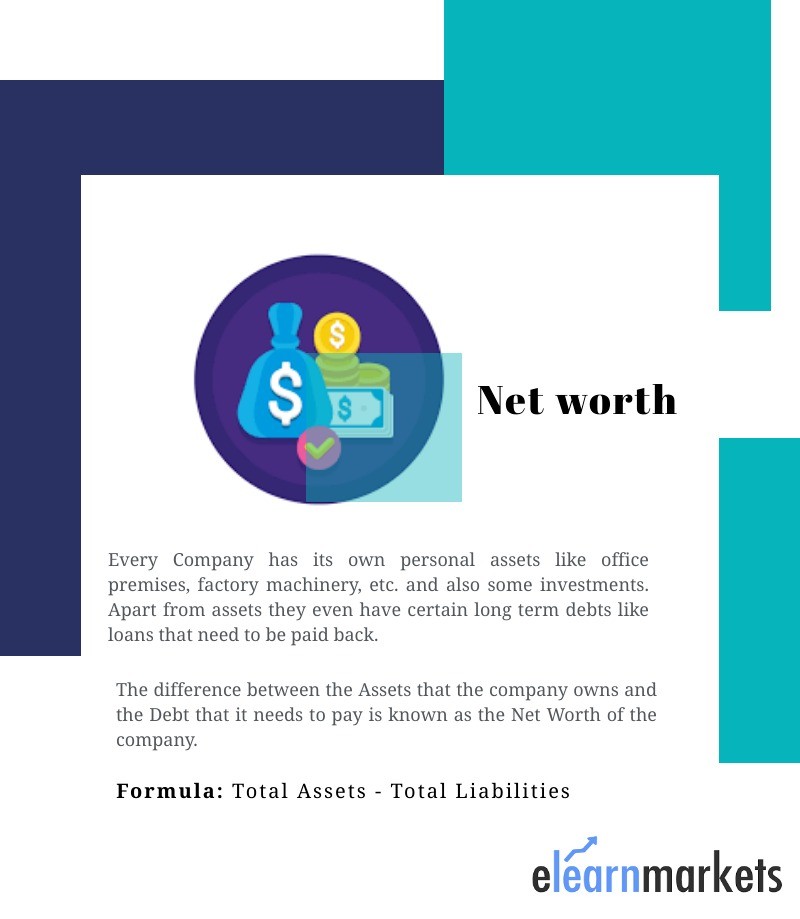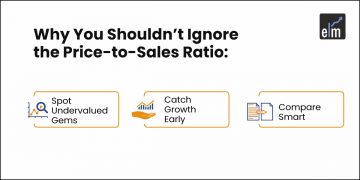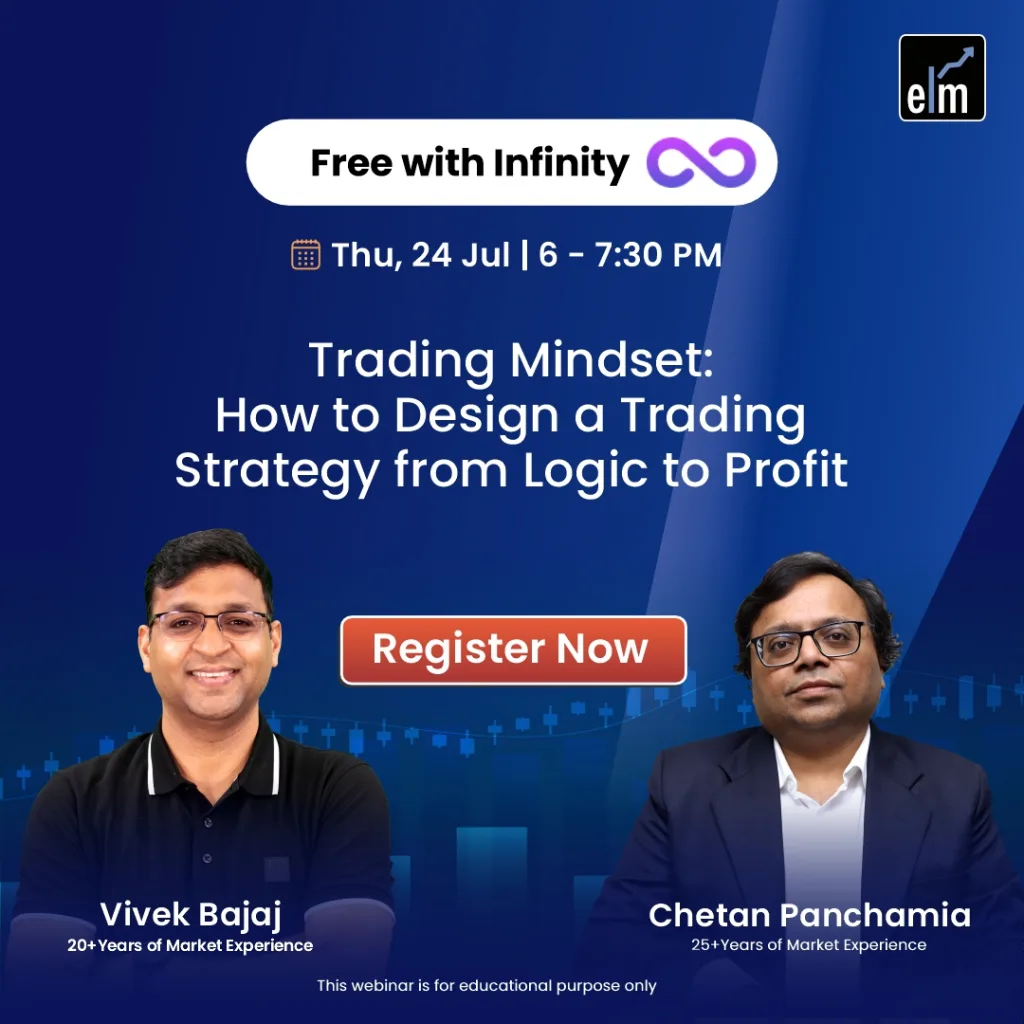Whenever one wants to start their Investment destination, knowing the correct value of their stock is prima facie. So understanding what is Net Worth is the first step for taking any investment decision.
| Table of Contents |
|---|
| What is Net Worth? |
| Net Worth Example |
| Where do I find Net Worth? |
| Why Net Worth is Important? |
| What is Return on Net Worth? |
What is Net Worth?
Every Company has its own personal assets like office premises, factory machinery, etc., and also some investments. Apart from assets they even have certain long-term debts like loans that need to be paid back.
Therefore the difference between the Assets that the company owns and the Debt that it needs to pay is known as the Net Worth of the company.
It represents the total value of a company.
Net Worth Example:
Suppose you have a Company name QWERTY ltd. It is a company that provides transport facilities.
It has around 100 trucks in its warehouses. Truck transfers the raw materials to different places on behalf of different companies.
The company has invested the cash to buy around 70 trucks, build up a warehouse, its office building.
It has to even take up the loan to purchase the rest of the trucks and also their parts which are its Asset.
So the company will calculate the difference between its assets and loans in order to find the value of the company.
This value of the company is considered what is the Net Worth of the company.
Thus in accounting terms, it is the difference between the asset that the company owns and the liability that it owes.

Where do I find Net Worth?
Since net worth is the value of the company that is found after subtracting the asset owned by the company and the liability that it owes.
Therefore in the Balance Sheet, you can find Equity Shareholders under the Equity and Liability section as it represents Company’s Net Worth.
Why Net Worth is Important?
Net Worth represents the total value of the Company. It helps to make a future investment plan and helps to set a financial goal for the company.
As it gives an overview of the company’s financial strength and indicates whether the company is in a position to do CAPEX or not.
What is the net worth of a company basically indicates the company’s creditworthiness.
Investors, and shareholders calculate the Return on Net worth to get an idea of the Company’s worth.
What is Return on Net Worth (RoWN)?
Return on net worth indicates the profitability of the company by providing the picture of how much return it earns on its capital. It shows whether or not the company is efficient enough to grow its network every year for the future growth potential of the company.
A higher ratio indicates that the company is utilizing the money of the shareholders in an efficient manner.
On the other hand, a lower ratio indicates that the company is not using the money efficiently. It is not investing the cash in a good opportunity.
Net Worth Formula:
The RoNW formula is the division of Net income by Net Worth. This is calculated at the year-end when annual reports are available.
RETURN ON NET WORTH = NET INCOME/NET WORTH
NET WORTH FORMULA: – SHAREHOLDER’S EQUITY + RESERVES + PREFERENCE SHARE CAPITAL- MISCELLANEOUS EXPENSES
A lower ratio indicates that the company is not using the shareholder’s fund in growing the business thus decreasing the creditworthiness of the company.
Let us understand the net worth formula with an example:
Company: – Vodafone Idea Ltd.
Net Profit/ (Loss) as on March’19 (Rs in crores) = (14,801)
Net Worth as on March’19 (Rs in crores) =59,635
Return on net worth = (14,801)/59,635
=(0.248)
As on March FY19 Net income is negative and total shareholder’s equity is Rs. 59635 cr.
The return on net worth is negative for this company. It gives a negative impact on the Company.
Impact:
Since return is negative it indicates that no return is being provided to the shareholder’s for every fund so invested.
The Creditworthiness of the company is decreasing as it is not in a position to raise funds from the market in order to increase the efficiency of the business. In order to improve the return company should pay off its debt and decrease its miscellaneous expenditure.
As higher or positive return on net worth is better for the company as it improves the company’s position to raise the funds from the market.
Let us understand what is net worth impact with the help of an example:-
Company: – Reliance Industries
Net Profit/(Loss) as on March’19 (Rs in crores) = 39,734
Net Worth as on March’19 (Rs in crores) =3,87,112
Return on net worth = 39,734/ 3,87,112
= 0.1026
Return on Net Worth is 0.1026 which is good for the shareholders.
As it indicates that the company is smoothly running the business by utilizing the shareholder’s funds efficiently.
The creditworthiness of the company increases. It even motivates the shareholders to invest more funds in the company, helping the company to improve its net worth.
Higher or positive net worth helps the company in improving future goals and setting the best future plans for the company.
It improves the financial strength of the company by increasing the opportunity to raise funds from the market. It increases the goodwill of the company.
Lower or positive net worth indicates that the company needs to decrease its liabilities as soon as possible and efficiently utilize the shareholder’s fund so that it provides better returns to the shareholders. To learn more about company valuation with Elearnmarkets learning app give you access to all the resources at one tap of a mobile phone.
It shows that company is not financially strong thus decreasing the chance to raise more funds.
Key Takeaways:
- Net Worth represents the total value of the company.
- In the Balance Sheet, Total Equity represents the net worth of the company.
- It gives an indication of the Company’s financial strength.
- A higher or positive return on net worth increases the creditworthiness of the company and helps to make better investments and finance future plans.
- A lower or negative return on what is net worth provides a negative impression about the company as it is not utilizing the funds of the shareholders efficiently. Thus, decreasing the creditworthiness of the company.
Happy Learning!







